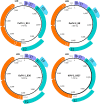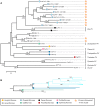New Insight Into Avian Papillomavirus Ecology and Evolution From Characterization of Novel Wild Bird Papillomaviruses
- PMID: 31031718
- PMCID: PMC6473165
- DOI: 10.3389/fmicb.2019.00701
New Insight Into Avian Papillomavirus Ecology and Evolution From Characterization of Novel Wild Bird Papillomaviruses
Abstract
Viruses in the family Papillomaviridae have circular dsDNA genomes of approximately 5.7-8.6 kb that are packaged within non-enveloped, icosahedral capsids. The known papillomavirus (PV) representatives infect vertebrates, and there are currently more than 130 recognized PV species in more than 50 genera. We identified 12 novel avian papillomavirus (APV) types in wild birds that could represent five distinct species and two genera. Viruses were detected in paired oropharyngeal/cloacal swabs collected from six bird species, increasing the number of avian species known to harbor PVs by 40%. A new duck PV (DuPV-3) was found in mallard and American black duck (27.6% estimated prevalence) that was monophyletic with other known DuPVs. A single viral type was identified in Atlantic puffin (PuPV-1, 9.8% estimated prevalence), while a higher genetic diversity was found in other Charadriiformes. Specifically, three types [gull PV-1 (GuPV-1), -2, and -3] were identified in two gull species (estimated prevalence of 17% and 2.6% in American herring and great black-backed gull, respectively), and seven types [kittiwake PV-1 (KiPV-1) through -7] were found in black-legged kittiwake (81.3% estimated prevalence). Significantly higher DuPV-3 circulation was observed in spring compared to fall and in adults compared to juveniles. The studied host species' tendencies to be in crowded environments likely affect infection rates and their migratory behaviors could explain the high viral diversity, illustrating how host behavior can influence viral ecology and distribution. For DuPV-3, GuPV-1, PuPV-1, and KiPV-2, we obtained the complete genomic sequences, which showed the same organization as other known APVs. Phylogenetic analyses showed evidence for virus-host co-divergence at the host taxonomic levels of family, order, and inter-order, but we also observed that host-specificity constraints are relaxed among highly related hosts as we found cross-species transmission within ducks and within gulls. Furthermore, the phylogeny of viruses infecting the Charadriiformes did not match the host phylogeny and gull viruses formed distinct monophyletic clades with kittiwake viruses, possibly reflecting past host-switching events. Considering the vast PV genotype diversity in other hosts and the large number of bird species, many more APVs likely remain to be discovered.
Keywords: avian papillomavirus; molecular epidemiology; papillomavirus; viral ecology; virus discovery; virus evolution.
Figures





Similar articles
-
Discovery and Characterization of Novel RNA Viruses in Aquatic North American Wild Birds.Viruses. 2019 Aug 21;11(9):768. doi: 10.3390/v11090768. Viruses. 2019. PMID: 31438486 Free PMC article.
-
Variation in viral shedding patterns between different wild bird species infected experimentally with low-pathogenicity avian influenza viruses that originated from wild birds.Avian Pathol. 2011 Apr;40(2):119-24. doi: 10.1080/03079457.2010.540002. Avian Pathol. 2011. PMID: 21500030
-
Natural history of avian papillomaviruses.Virus Res. 2018 Jul 2;252:58-67. doi: 10.1016/j.virusres.2018.05.014. Epub 2018 May 17. Virus Res. 2018. PMID: 29778701 Review.
-
Reassortment of American and Eurasian genes in an influenza A virus isolated from a great black-backed gull (Larus marinus), a species demonstrated to move between these regions.Arch Virol. 2011 Jan;156(1):107-15. doi: 10.1007/s00705-010-0839-1. Epub 2010 Nov 4. Arch Virol. 2011. PMID: 21053031
-
Molecular methods for identification and characterization of novel papillomaviruses.Clin Microbiol Infect. 2015 Sep;21(9):808-16. doi: 10.1016/j.cmi.2015.05.011. Epub 2015 May 21. Clin Microbiol Infect. 2015. PMID: 26003284 Review.
Cited by
-
Discovery and Genomic Characterisation of Novel Papillomaviruses in Australian Wild Birds.Pathogens. 2025 May 22;14(6):514. doi: 10.3390/pathogens14060514. Pathogens. 2025. PMID: 40559522 Free PMC article.
-
Multi-host dispersal of known and novel carnivore amdoparvoviruses.Virus Evol. 2020 Dec 6;6(2):veaa072. doi: 10.1093/ve/veaa072. eCollection 2020 Jul. Virus Evol. 2020. PMID: 36158990 Free PMC article.
-
First Report of Phodopus sungorus Papillomavirus Type 1 Infection in Roborovski Hamsters (Phodopus roborovskii).Viruses. 2021 Apr 23;13(5):739. doi: 10.3390/v13050739. Viruses. 2021. PMID: 33922632 Free PMC article.
-
Identification of a Novel Papillomavirus Type (MfoiPV1) Associated with Acrochordon in a Stone Marten (Martes foina).Pathogens. 2021 Apr 30;10(5):539. doi: 10.3390/pathogens10050539. Pathogens. 2021. PMID: 33946165 Free PMC article.
-
The characterization of two novel neotropical primate papillomaviruses supports the ancient within-species diversity model.Virus Evol. 2020 Jun 30;6(1):veaa036. doi: 10.1093/ve/veaa036. eCollection 2020 Jan. Virus Evol. 2020. PMID: 32665860 Free PMC article.
References
LinkOut - more resources
Full Text Sources
Research Materials
Miscellaneous

